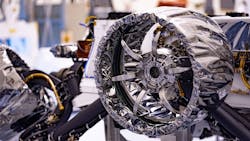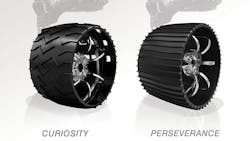NASA’s Latest Martian Rover Gets New Wheels and a “Brake Job”
Final assembly and testing of NASA's Perseverance rover continues at Kennedy Space Center in Florida as the July launch window approaches. Perseverance is scheduled to liftoff aboard a United Launch Alliance Atlas V 541 rocket from Cape Canaveral Air Force Station this July.
In some of the last steps required prior to packing the rover’s components in the configuration they’ll be in atop the Atlas V rocket, the rover’s wheels and parachute were just installed.
The 2,260-lb Perseverance had its six flight wheels installed on March 30. Although the rover took a test drive last December, it was on “flight spares” that won’t be making the trip to Mars. The wheels are upgraded versions of the ones NASA’s Curiosity using as it explored Mars’ Mount Sharp. They are designed for the kind of off-roading Perseverance will perform.
Each wheel is machined out of a block of flight-grade aluminum and equipped with titanium spokes. They are slightly larger in diameter and narrower than Curiosity’s, with skins almost a millimeter thicker. They also feature new treads, or grousers: In place of Curiosity’s 24 chevron-pattern treads, Perseverance has 48 gently curved ones. Extensive testing in the Mars Yard at NASA’s Jet Propulsion Laboratory, which built the rover and manages operations, showed that the new treads better withstand the pressure from sharp rocks and grip just as well or better than Curiosity’s when driving on sand.
Mounting Perseverance’s parachute (its air brakes) to the back shell, where the rover will be stowed on its journey to the Red Planet, took several days. It will slow the heaviest payload in the history of Mars exploration from Mach 1.7 (1,300 mph) to about 200 mph during the rover’s February landing. The parachute consists of 194 lb of nylon, Technora and Kevlar fibers packed tightly into a 20-in.-wide cylinder. When deployed at about 7 miles above the surface of Martian surface, the chute will take about a half-second to fully inflate its 70.5-foot-wide canopy. In tests, the cute created almost 70,000 lb of force when it opened.
The Perseverance will search for signs of past microbial life, characterize the planet’s climate and geology, collect samples for its future return to Earth, and pave the way for human exploration of the Red Planet. No matter what day Perseverance launches during its July 17-Aug. 5 launch window, it will land on Mars’ Jezero Crater on Feb. 18, 2021.
Perseverance is part of a larger program that includes missions to the Moon as a way to prepare for human exploration of the Red Planet. Charged with returning astronauts to the Moon by 2024, NASA will establish a sustained human presence on and around the Moon by 2028 through NASA’s Artemis lunar exploration plans.



